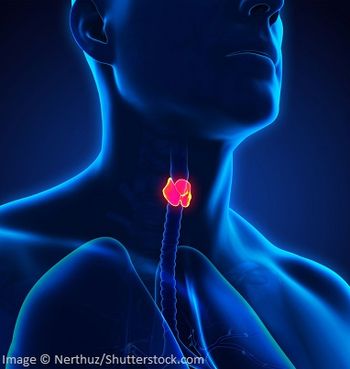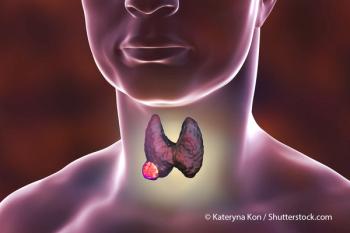
Hemithyroidectomy Rates Increase Following Guideline Change
In late 2015, the American Thyroid Association (ATA) changed guideline recommendations trying to rein in overly aggressive treatment of thyroid cancers that are low risk, offering the choice of hemithyroidectomy as an alternative to total thyroidectomy in these patients. In participating hospitals, the rates of hemithyroidectomy went up.
In late 2015, the American Thyroid Association (ATA) changed guideline recommendations to rein in overly aggressive treatment of thyroid cancers that are low-risk. The new recommendations offered the choice of hemithyroidectomy as an alternative to total thyroidectomy in these patients. As a result, the rates of hemithyroidectomy went up in participating hospitals, per results of a study published in
“We hypothesized that, after the release of the 2015 ATA guidelines, surgeons would perform HT [hemithyroidectomy] increasingly for low-risk thyroid cancers, despite the controversy,” wrote authors led by Timothy M. Ullmann, MD, Department of Surgery, Weill Cornell Medical College, New York-Presbyterian Hospital, New York, NY. “To examine these trends on a national scale, we queried the database of the National Surgery Quality Improvement Program (NSQIP). NSQIP represents a broad sampling of hospitals that volunteer to participate and includes data extracted directly from patient charts at individual institutions rather than relying on insurance claims data, which may be incomplete or inaccurate.”
The authors mined the NSQIP database for all patients who received thyroidectomy between 2009 and 2017. In total, 35,291 patients (76.2% female; 71.3% white) were compared on the basis of whether they received surgery before or after the release of the ATA guidelines. Of note, the guidelines were published online in October 2015. Trends in operative rates were analyzed quarterly via interrupted time-series analyses.
An increase in hemithyroidectomy rates from 17.3% to 22.0% (P < .001) was observed. Furthermore, after controlling for covariates, quarterly rates of hemithyroidectomy ballooned nearly 1000% following publication of the guidelines (P < .001).
No increase in complete thyroidectomy was observed before and after the release of the 2015 ATA guidelines (8.3% vs 7.9%, respectively, P = .213). In other findings, those receiving hemithyroidectomy were more likely to be treated outpatient (70.8% vs 57.1%, P < .001); experience fewer surgical site infections (0.3% vs 0.5%, P = .050); and need fewer unplanned reintubations (0.2% vs 0.4%, P = .005).
This increase in hemithyroidectomy rates was observed among general surgeons and otolaryngologists alike. Otolaryngologists, however, were more likely to perform hemithyroidectomy at baseline, which could be due to discrepancies in referral or practice patterns. The authors hypothesize that higher baseline hemithyroidectomy rates among otolaryngologists may be why general surgeons demonstrated the biggest jump in hemithyroidectomy rates following release of the new ATA guidelines.
The 2015 ATA guidelines are considered the gold standard and update the 2009 version. The new guidelines call for diminished diagnostic testing in patients presenting with thyroid nodules, as well as less extensive operations for patients with low-risk differentiated thyroid cancers (DTCs).
Several changes in the guidelines deal with de-escalating operative therapy for patients with low-risk DTCs, in light of the understanding that more extensive thyroid resections did not extend overall or disease-specific survival.
The most substantial change in the 2015 ATA guidelines was balancing hemithyroidectomy with total thyroidectomy in the treatment of patients with intrathyroidal DTCs sized 1 cm–4 cm. This change was based on a number of high-power, retrospective studies that suggested noninferior overall survival for DTC patients with low-risk neoplasms who underwent hemithyroidectomy vs. total thyroidectomy.
“Surgeons at hospitals that participate in the National Surgery Quality Improvement Program may be changing practice patterns in response to these guidelines,” concluded the authors.
“This study of the NSQIP database provides continuing evidence of the de-escalation in low risk thyroid cancer management that has evolved over the last several decades, namely, that more patients are undergoing hemithyroidectomy as opposed to total thyroidectomy,” said Mark Zafereo, M.D., section chief of Head & Neck Endocrine Surgery and associate professor of Head & Neck Surgery at The University of Texas MD Anderson Cancer Center, Houston, in an interview with Cancer Network. “This trend in less extensive surgery for low risk thyroid cancer patients should result in overall better quality of life and decreased cost of care. In addition to less extensive thyroid surgery, other studies have also documented that fewer patients are receiving radioactive iodine therapy, another example of treatment de-escalation for patients with low risk thyroid cancer.”
Newsletter
Stay up to date on recent advances in the multidisciplinary approach to cancer.





